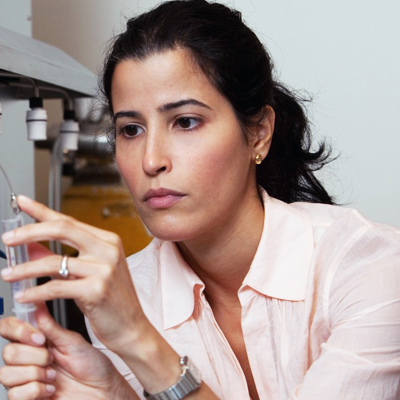How controlled disassembly of materials can be used for localized disease detection and treatment
Light- and disease-responsive materials hold tremendous potential to transform medicine and biological research. Both classes of materials could also allow selective delivery of drugs to disease sites, enhancing their efficacy and reducing side effects, and disease-responsive materials could enable detection of heart disease, cancer, and other common, serious conditions at much earlier stages, so that treatment would be more effective. The work of Prof. Adah Almutairi, Associate Professor in the Skaggs School of Pharmacy and Pharmaceutical Sciences at the University of California, San Diego, in this area is especially exciting because of their efforts to find clinical applications for these futuristic materials.
Prof. Almutairi’s research group designs nano- and microparticles that degrade on demand in a highly controlled fashion. These include light-responsive materials that degrade when a specific wavelength of light is applied, causing release of molecules, such as drugs, contained within the material. While her group has made impressive strides in creating materials that respond to wavelengths of light that penetrate tissue, their most feasible applications are those in which release is triggered near the body’s surface. One such application is as a light-responsive depot, which would reduce the frequency of drug injections.
A second class of materials under development in the Almutairi lab are those that degrade in response to inflammation, specifically to the chemicals that cause oxidative stress. They were the first to create a material that can respond to levels of these chemicals found in inflamed tissue, which are only slightly higher than levels in normal conditions. These could be used to deliver drugs selectively when and where inflammation occurs-- flare-ups would trigger release, while the drug would otherwise be conserved within nanoparticles. These can also be used to create imaging agents in which signal is turned on by release from nanoparticles in response to the oxidizing chemicals.
Current projects include the further development of both light-responsive and inflammation-responsive materials, and their application for:
-
Local delivery of drugs to treat haphazard blood vessel growth in age-related macular degeneration-- Prof. Almutairi’s team has shown that light-responsive nanoparticles can release these drugs in response to brief exposure to light. These drugs currently require monthly injections, so this approach could greatly reduce that frequency.
-
Development of imaging agents to distinguish inflamed arterial plaque (likely to break and cause a heart attack) from less dangerous lipid accumulation-- current diagnostics cannot distinguish these types of plaque, so this work could save lives by indicating when aggressive intervention is needed and when that intervention has succeeded.
-
Prophylactic therapy for the systemic inflammatory response to infection or traumatic injury-- the lab has found that delivering an anti-inflammatory drug in inflammation-responsive particles is more effective than the drug alone in preventing mortality from toxin injection in mice. This work could have enormous public health impact, as there is currently no effective treatment for this deadly condition.
As light-degradable materials would allow release from a depot residing just below the skin, Prof. Almutairi is also considering developing a depot approach to insulin delivery, where the patient could shine light to release insulin, instead of having to inject the drug multiple times per day.
Bio
When she was headed to college, Dr. Almutairi was planning to follow her passion for numbers and major in mathematics, but her chemistry professor Tetsuo Otsuki (affectionately referred to as Dr. O) invited her into his lab and introduced her to research as an undergraduate student. One of the benefits of attending a small liberal arts school is that it allowed Dr. Almutairi to work one-on-one with Dr. O, a rare experience that changed her experience of research and instilled in her a passion for discovery. Following Dr. O’s guidance, Dr. Almutairi decided to major in organic chemistry and to pursue a career in research.
Following her research with Dr. Otsuki, Dr. Almutairi was personally recruited with a full fellowship into a lab working on polymers that move in response to electrical charge offering. This work has practical applications, and Dr. Almutairi realized she wanted to create materials that help people. She believes in and appreciates both fundamental scientific knowledge and practical application, which is reflected by the research in her lab.
Her graduate advisor told Dr. Almutairi, “I couldn’t imagine you doing anything outside of academic work,” helping to steer her towards her current career, which she hadn’t seriously considered. A chance encounter led her to present to Jean Fréchet, a charismatic and inspirational speaker, which led to her postdoctoral work with him on polymers in medicine. She found this research area gratifying because people outside of the medical field can easily understand it and recognize its importance.
Her team is highly interdisciplinary, including synthetic chemists, materials scientists, bioengineers, biomedical scientists, and animal model specialists. She collaborates with several groups around the world, including a radiology lab in Pittsburgh, an inorganic materials/in vivo imaging lab at Stanford, an MR lab in Mons, Belgium, and a drug delivery group in Kyoto, Japan. These collaborations open new avenues for research and provide access to unique materials and advanced characterization capabilities.
In the News
Videos
Awards
Young Investigator, 2014
Division of Polymeric Materials Science & Engineering, American Chemical Society
ChemComm Emerging Investigator, 2014
Royal Society of Chemistry
NIH New Innovator Award, 2009-2014
Young Investigator Award, 2012
World Biomaterials Congress, Chengdu, China
Polymer Science Award, 2012
IUPAC Polymers & Organic Chemistry Conference 2012, Doha, Qatar


